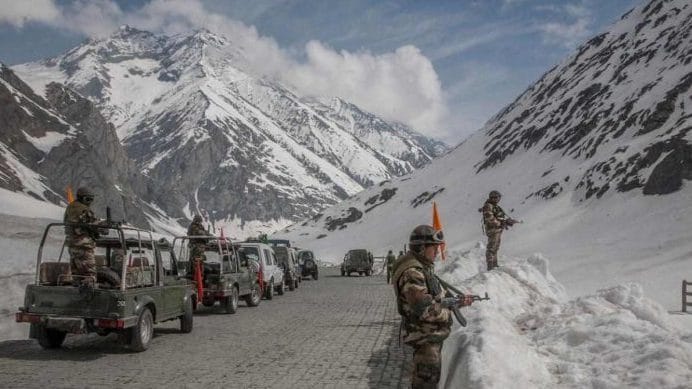New Delhi: The Indian Army Monday carried out a “physical verification” of Chinese pullout from the Depsang Plains and Demchok to ensure everything has been according to the agreement signed by the Corps Commander on 21 October, The Print has learnt.
Sources in the defence and security establishment said the verification was done according to the mutually-agreed standard operating procedure.
This was to ensure that the Chinese army had dismantled the tents, defences, vehicles and other elements it was supposed to pull down.
The sources said the Indian Army will carry out their first patrol to patrolling points (PP) 10, 11, 12, 12A, 13 shortly. This would be the first time since January 2020 that the Indian Army will be patrolling these areas, they added.
While Indian soldiers were mostly stopped from the patrolling points in Depsang Plains in mid-2017 from an area called the Y-Junction, they managed to push their way through in January 2020.
As reported by ThePrint, a decision has been taken to limit the patrolling to twice a month and both sides will coordinate with each other.
This means that each side will inform the other before embarking on the scheduled patrolling. This, the sources said, was to ensure that no kind of confrontation takes place.
Also Read: “Will take time to build trust and willingness”: EAM Jaishankar on India-China relations
No quid pro quo, says Army
Even though Army sources have emphasised that the agreement was specific to only Depsang and Demchok, sources told ThePrint that an understanding has also been reached for restart patrolling in areas where buffer zones were created—northern banks of Pangong Tso, Galwan Valley, Hot Springs, Gogra—where disengagement took place by September 2022.
Indian and Chinese military commanders were still in talks over patrolling in the earlier-created buffer zones, and that would be a separate agreement, the Army sources said.
“Understanding has been reached. First patrolling will start in Depsang and Demchok. Once the situation stabilises here, a formal agreement will be inked for other places and patrolling will start there as well,” one of the sources said.
The Army sources also said that there was no quid pro quo and that talks were on between India and China along the entire Line of Actual Control (LAC).
Also Read: Indian Army’s first brush with the PLA was in 1951. The windfall was Chushul airfield
Escorted patrolling in Arunachal
The sources told ThePrint that an understanding has also been reached for allowing “escorted patrolling” of the Chinese in the contested Yangtse region of Arunachal Pradesh’s Tawang and possibly in one more area.
It was not immediately known when this would start.
Yangtse is now heavily dominated by the Indian Army. Prior to 2020, the Chinese Army would patrol to a particular point in Yangtse, one of the contested points along the LAC.
Incidentally, the Indian Army had occupied Yangtse in 1987 in response to the Chinese intrusion in Sumdorong Chu.
Yangtse fell within India’s claim lines but was never occupied until 1987. It is only when the Chinese invaded Sumdorong Chu that the Indian Army decided to occupy Yangtse, much to the discomfort of the People’s Liberation Army (PLA). The Sumdorong Chu intrusion led to a protracted military confrontation, which was only resolved after diplomatic negotiations in the mid-1990s.
One big disadvantage for the PLA in this area is that the Indian Army occupies all the heights, including the post at 17,000 ft, which gives a full view of Chinese positions.
The sources said the Chinese movement can be visible for 30 minutes every time they advance towards Indian posts.
As reported earlier, the Chinese were peeved in 2020 when Arunachal Pradesh Chief Minister Pema Khandu inaugurated a gompa under the Chumi Gyatse waterfalls, just about 250 m from the LAC, which the Chinese consider their territory.
Since 2020, the state government and the Army have been developing the area around the waterfalls, which is highly revered by the Monpas or the Tibetan Buddhists, one of Arunachal’s main tribes with population scattered in Tawang and West Kameng districts, on both sides of the border.
India has also constructed a road to the remote Tsechu village near the LAC, where the Chumi Gyatse falls from a height of 11,000 ft.
Post the Chinese intrusion in Eastern Ladakh disregarding the formal agreements signed between the two countries and ground level informal tactical understanding, the Indian Army activated its troops all along the LAC.
The Army then moved ahead within its dominated territory to prevent any Chinese patrolling. The new move led to major issues with the Chinese, who had twice tried to break through, leading to physical clashes since then.
The sources remained tight-lipped about what escorted patrolling would entail, while another set of sources said this could mean Chinese soldiers would be allowed into a specific area with Indian troops observing them.
(Edited by Tikli Basu)
Also Read: Depsang ‘resolved’, patrolling to ‘agreed perceived LAC’. What India and China have agreed on






